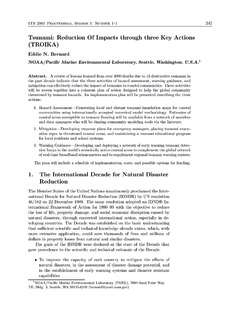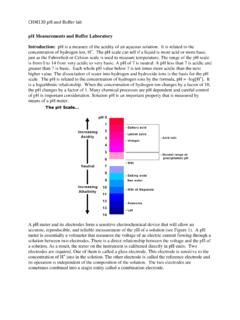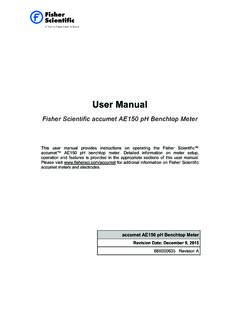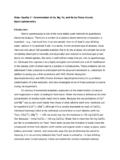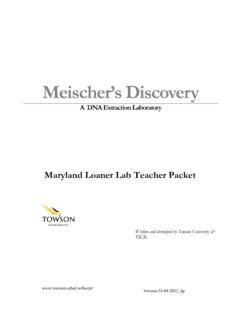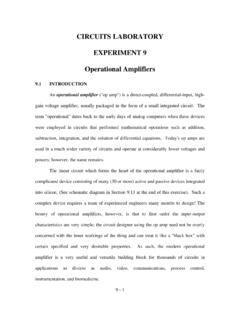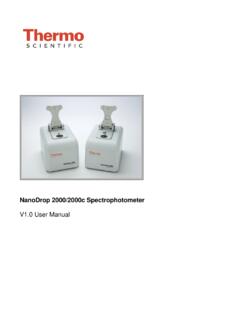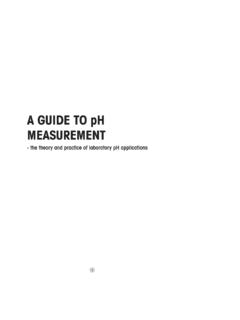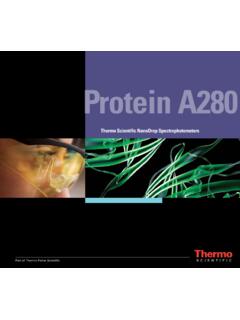Transcription of Part 1: Seawater carbonate chemistry
1 17 The carbon dioxide system in Seawater : equilibrium chemistry and measurements1 Andrew G. DicksonScripps Institution of Oceanography, University of California, USA The world s oceans can be thought of as a dilute solution of sodium bicarbonate (together with other acid-base species at still lower concentrations) in a saltwater background. In the surface waters of the North Atlantic, for example, the concentration of total dissolved inorganic carbon (the sum of the concentrations of the three coexisting species: bicarbonate ion, carbonate ion, and unionised dissolved carbon dioxide) is only about 2 mmol kg 1. About 90% of this is present as bicarbonate ion, the proportion of carbonate ion is about a factor of 10 less (~10%), and that of unionised carbon dioxide yet another factor of 10 less (<1%).
2 As a result of the equilibria between these various species (see below), Seawater is buffered (weakly) with respect to changes in hydrogen ion (present at much lower concentrations: <10 8 mol kg 1).Over the past twenty years, accurate measurement of the Seawater carbon dioxide system has become a high priority for scientists who have worked to understand just how much of the carbon dioxide (CO2) created by man s activities has ended up in the ocean, where it is distributed, and how it has changed the chemistry of the oceans. The chemical changes associated with the increase of CO2 in the oceans are often referred to as ocean acidifi cation. As we work to design suitable experiments to understand the biological and ecological consequences of such changes, it is important that the chemistry of CO2 be well characterised in the various laboratory experiments and fi eld observations that are undertaken.
3 Achieving this requires an understanding of the basic solution chemistry underlying ocean acidifi cation, as well as of the relative merits of the various analytical techniques available to the from the point of view of someone desiring simplicity in addition to carbon dioxide there are other acid-base systems in Seawater that complicate things, particularly in systems that are not typical of the open surface ocean, with its low nutrient levels and relatively low amounts of dissolved organic material. The approach I shall take in this chapter is to introduce fi rst a somewhat simplifi ed view of acid-base chemistry in Seawater involving only the primary Seawater acid-base systems: carbonic acid, boric acid and water. These will be discussed in some detail, and used to introduce the classical oceanographic analytical parameters for carbon dioxide studies in Seawater : total dissolved inorganic carbon, total alkalinity, pH, and p(CO2) the partial pressure of carbon dioxide that is in equilibrium with a water sample (Box ).
4 The concept of calcium carbonate saturation state will also be introduced. Once this basic Seawater chemistry has been presented and assimilated it will be appropriate to revisit a number of these topics and to introduce further complexity, so as to clarify how these various concepts can be applied appropriately in the Seawater systems that are of interest to investigators in ocean acidifi cation. Finally, I shall present a brief discussion of some of the current techniques available for the measurement of the various parameters of the Seawater carbon dioxide system, and will indicate their advantages and disadvantages. The advantages and disadvantages of using alternate combinations of parameters to provide a complete description of the composition of a particular Seawater sample will also be discussed.
5 As will become clear, at this time it is not as straightforward as one might wish to characterise the state of a particular Seawater sample s carbonate chemistry and to assign a well-constrained measurement uncertainty. Investigators who wish to do high quality work in ocean acidifi cation, but who have little previous experience in Seawater CO2 measurements, would do well to collaborate with a scientist with experience in this area and who has access to a working laboratory that can perform the necessary measurements with the required to best practices for ocean acidifi cation research and data reportingEdited by U. Riebesell, V. J. Fabry, L. Hansson and Gattuso. 2010, Luxembourg: Publications Offi ce of the European 1: Seawater carbonate chemistry18 Part 1: Seawater carbonate chemistryBox : Terminology and units for parameters relevant to the carbonate systemHans-Otto P rtner, Andrew Dickson and Jean-Pierre GattusoResearch in ocean acidifi cation brings together various scientifi c disciplines such as chemistry , geology, biogeochemistry, ocean physics and various sub-disciplines of biology and ecology (biological oceanography, marine ecology and ecological physiology, biochemistry, physiological chemistry and molecular biology).
6 Each of these disciplines generally investigates ocean acidifi cation from its own point of view, building on its own traditions with the goal of providing the highest possible accuracy under the constraints of each fi eld. Ideally, effi cient communication should use a unifi ed set of terms and units in scientifi c presentations, discussions and publications and when differences exist, they must be clearly documented and understood. A large number of terms and units are used to describe the physicochemical properties of the carbonate system in Seawater and in the biological material and fl uids that interact with Seawater (Table). Marine chemistry uses them to quantify changes in Seawater acid-base composition. Acid-base physiology uses similar terms to estimate the quantities of protons or base equivalents moving between water and organism as well as between body compartments causing changes in body fl uid composition ( P rtner et al.)
7 , 1991). The aim of this box is to alert readers to parameters ( pH, dissolved inorganic carbon) that are defi ned differently in marine chemistry (see chapter 1) and physiology (see chapter 9) and to describe the main terms and units used in this guide. pH is the parameter that causes most diffi culties. Marine chemistry has developed the total hydrogen ion concentration scale. It requires buffers prepared in synthetic Seawater for calibration (Hansson, 1973; Dickson et al., 2007). This scale includes the effect of sulfate ion in its defi nition. From a physiological perspective, the use of a free hydrogen ion concentration scale would be more appropriate than the total scale as it does not include sulfate protonation in its defi nition.
8 It is possible to convert a pH value from the total scale to the free scale and vice versa (Zeebe & Wolf-Gladrow, 2001) in Seawater of a known salinity, and software tools are available to achieve this (Lavigne & Gattuso, 2010). The free scale could also be used to express pH of the extracellular fl uids of marine invertebrates. However, neither the total scale nor the free scale can be used straightforwardly for pH determinations in intracellular fl uids and in extracellular fl uids of vertebrates, which have ionic strengths of about one third of that of Seawater . The conventional NBS pH scale is therefore commonly used in physiology for such sum of the concentrations of all inorganic carbon species is termed total dissolved inorganic carbon (DIC or CT) in the fi eld of marine chemistry and total CO2 (CCO2) in the fi eld of physiology.
9 These terms are not always synonymous, especially in body fl uids where CCO2 may also include inorganic CO2 species bound to protein. Furthermore, different (though related) titration procedures are used to determine total alkalinity (by use of strong acid) in Seawater and titratable acid(ity) (by use of strong base) in physiological fl uids like urine. In tissues and blood, the CO2/bicarbonate buffer system is distinguished from non-bicarbonate buffers, when analysing the titration of the latter by accumulating CO2, by metabolic infl uences, or during proton-equivalent ion exchange. 19 References cited:Dickson A. G., Sabine C. L. & Christian J. R. (Eds.), 2007. Guide to best practices for ocean CO2 measurements. PICES Special Publication 3: I.
10 , 1973. A new set of pH-scales and standard buffers for sea water. Deep-Sea Research 20, 479-491 Lavigne H. & Gattuso , 2010. seacarb: Seawater carbonate chemistry with R. R version rtner , Andersen N. A. & Heisler, N. 1991. Proton equivalent ion transfer in Sipunculus nudus as a function of ambient oxygen tension: relationships with energy metabolism. Journal of Experimental Biology 156:21-39. Zeebe R. E. & Wolf-Gladrow D. A., 2001. CO2 in Seawater : equilibrium, kinetics, isotopes. 346 p. Amsterdam: : Main parameters describing the physicochemistry of Seawater and body fl uids and their differences in the fi elds of marine chemistry and physiology. The notation and units used in this guide are also shown.
